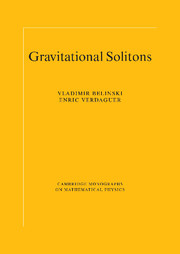Book contents
- Frontmatter
- Contents
- Preface
- 1 Inverse scattering technique in gravity
- 2 General properties of gravitational solitons
- 3 Einstein–Maxwell fields
- 4 Cosmology: diagonal metrics from Kasner
- 5 Cosmology: nondiagonal metrics and perturbed FLRW
- 6 Cylindrical symmetry
- 7 Plane waves and colliding plane waves
- 8 Axial symmetry
- Bibliography
- Index
7 - Plane waves and colliding plane waves
Published online by Cambridge University Press: 17 August 2009
- Frontmatter
- Contents
- Preface
- 1 Inverse scattering technique in gravity
- 2 General properties of gravitational solitons
- 3 Einstein–Maxwell fields
- 4 Cosmology: diagonal metrics from Kasner
- 5 Cosmology: nondiagonal metrics and perturbed FLRW
- 6 Cylindrical symmetry
- 7 Plane waves and colliding plane waves
- 8 Axial symmetry
- Bibliography
- Index
Summary
The ISM can also be applied to plane-wave spacetimes as well as to spacetimes describing the collision of two plane waves. In this chapter we shall describe those spacetimes from the point of view of the ISM. In section 7.2 exact gravitational plane waves are defined and the plane-wave soliton solutions are characterized. We illustrate some of the physically more interesting properties of the plane waves with the detailed study of an impulsive plane wave. The more interesting case of solutions describing the head-on collision of plane waves is described in section 7.3. Soliton solutions are seen to describe the interaction region of such a collision since it can be described by a metric in which the transverse coordinates of the incoming plane waves can be ignored. Here again to illustrate the geometry of the colliding waves spacetimes we analyse in some detail a solution representing the head-on collision of two plane waves with collinear polarizations. Soliton solutions are described which include several of the most well known solutions representing the collision of waves with collinear and noncollinear polarizations.
Overview
Plane waves emerge as a subclass of a larger class of spacetimes: the pp-waves. Plane-fronted gravitational waves with parallel rays (pp-waves) are spacetimes that admit a covariantly constant null Killing vector field lμ, i.e. lμ;ν = 0, and were classified by Ehlers and Kundt [89].
- Type
- Chapter
- Information
- Gravitational Solitons , pp. 183 - 212Publisher: Cambridge University PressPrint publication year: 2001



